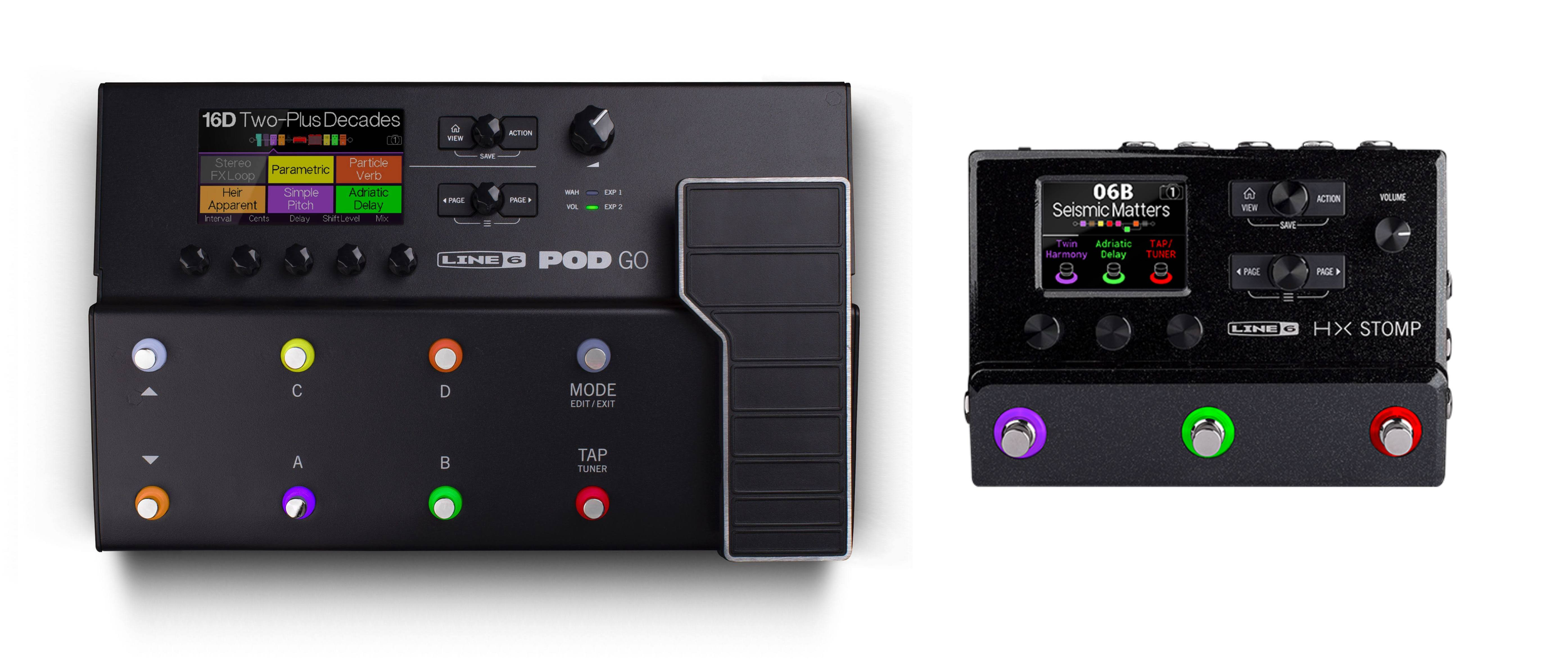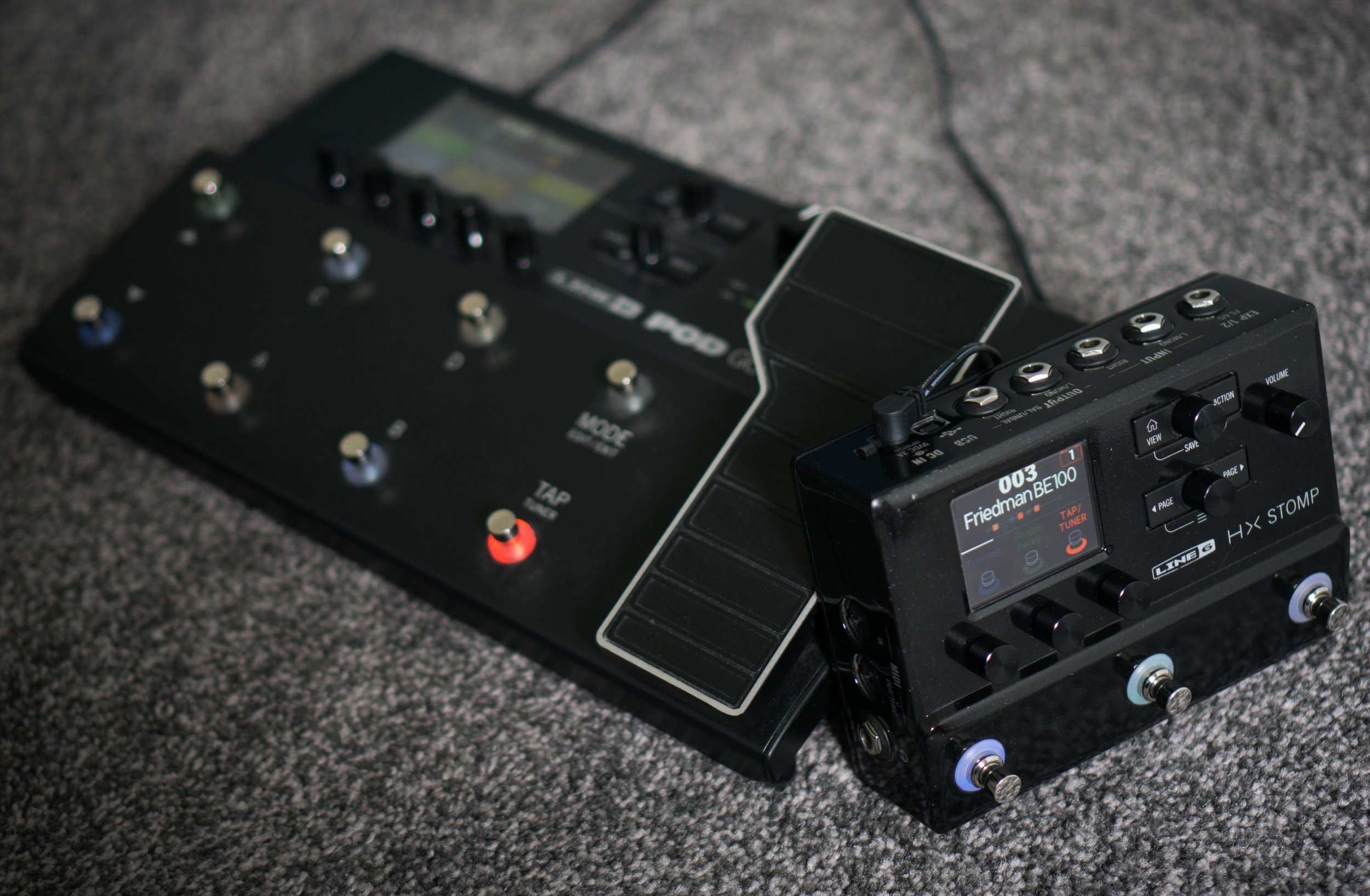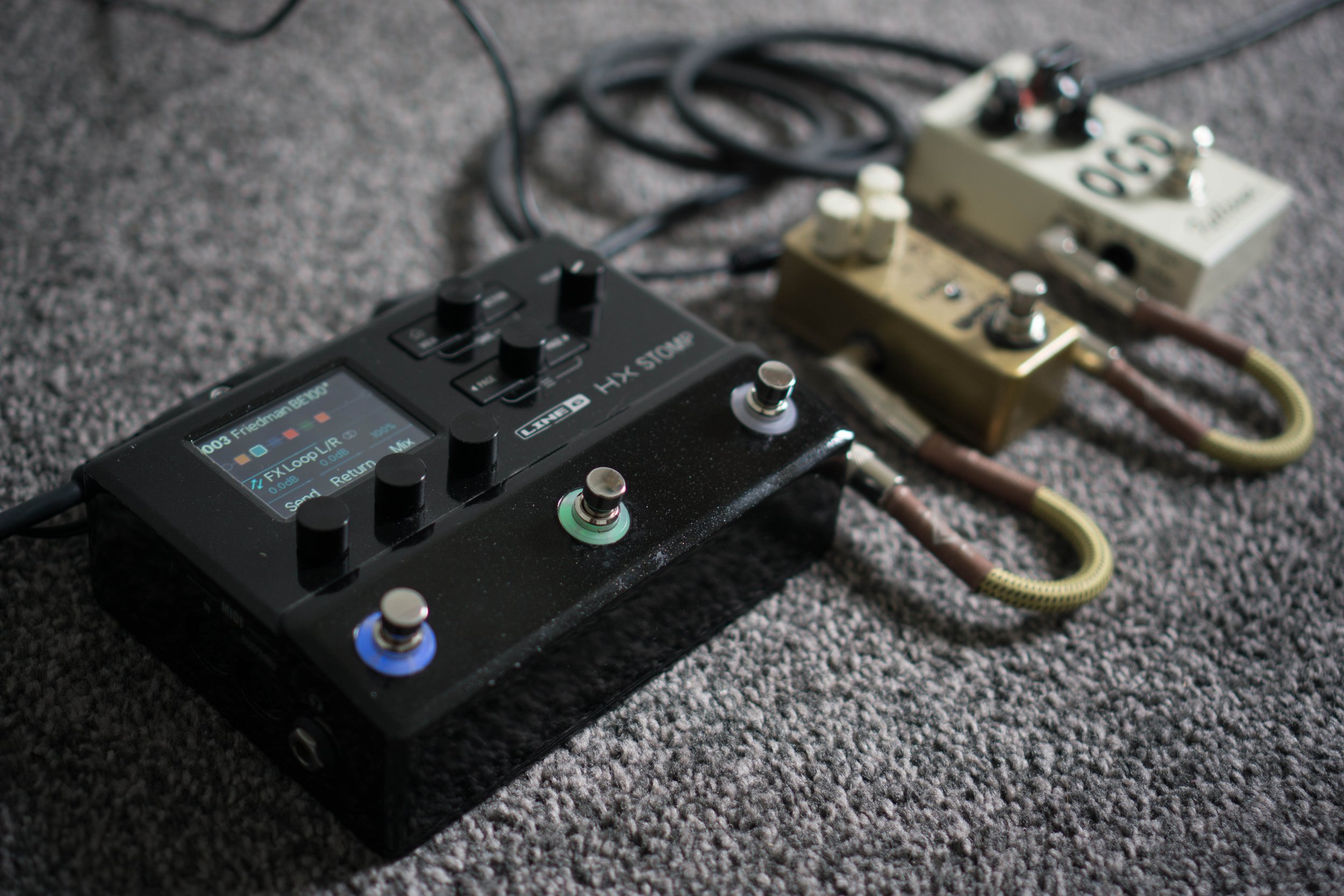Line 6 POD GO vs HX Stomp
Some of the best modelling gear on a budget.
Looking for an affordable do-it-all modeller that will sound as good as units three times the price? Line 6 has got you covered! Their Helix family has been steadily growing in size and popularity since the original units released 6 years ago. In this review, we will compare two of the smallest and most affordable units - the POD GO and the HX Stomp.
Sound
Firstly, let’s address the sound quality. They both sound the same and they both sound amazing. In fact, in a recording, I would be unable to tell the difference between a real amp and its corresponding Helix model. The HX Stomp has a slightly more powerful processing unit than the POD, but this only means that you can create more complex signal paths, which we will cover later.
The amp and effect models are excellent. They both mostly cover the same stuff - over 80 amp models (pretty much everything you could ever want from Fender to Soldano) and hundreds of effects, including models of “unobtainable” pedals, such as the KLON. There are very few models that are missing on the POD, but not the HX, most notably the Tone Sovereign (King of Tone). However, the POD does have an Heir Apparent (Prince of Tone) model, so you can use 2 of those in sequence to achieve the exact same effect, although this will consume 2 out of 3 free tone blocks.
Some people will claim that digital effects don’t sound authentic, but the reality is that you will struggle to tell the difference, especially in a mix. In addition, you can change the order of your pedals in seconds and have effectively infinite presets. So it becomes increasingly difficult to justify a heavy and bulky pedalboard.
Form Factor
The form factor will likely be the deciding factor between these two units for most players.
The HX Stomp is tiny. It is about the size of a double pedal and will easily fit in your gig bag. Pretty great for a pedal that can replace your entire signal chain, including the amp! It is also pedalboard friendly, which means that you could, for example, use it to fill the gaps in your existing pedalboard - delay, reverb, modulation. Because it has an effects loop, you could even use the Stomp as your tuner and tremolo at the start of the chain, place your physical pedals in the middle, and then finish off with the Helix delay and reverb models. Not a bad replacement for a tuner, right? It does, however, only have 3 footswitches, one of which is typically reserved for tap tempo and a tuner (although this can be changed in settings). Each footswitch can control multiple effects and even parameters at the same time. You can even have one footswitch cycle through the three snapshots in a preset, and the other - turn certain effects on and off. This essentially gives you 6 different sounds in a single preset, while still having access to the tuner!
Of course, you can further expand the capabilities of the HX Stomp by connecting either an expression pedal or a dual footswitch (but not both!) and set them up to control whatever parameters you like. You can get a compatible expression pedal for as little as £13. The controls can be expanded even further by adding a MIDI controller, either in the form of a desk unit or a footswitch controller. There are various third party units available ranging in price from £50 to several thousand. Connecting a MIDI controller can give you far more versatility than the default controls on the POD GO, but all of that will further increase the footprint and price of the already slightly more expensive HX Stomp.
The POD Go, on the other hand, is about the size of a small pedalboard and, likely, won’t fit in your gig bag. The larger size allows for 8, rather than 3 foot switches, an expression pedal with an additional footswitch, much bigger display, as well as a control scheme that is much more user friendly. The POD Go has 6 fully programmable footswitches for every preset, which I actually find to be too many in most cases. It has a tuner/tap tempo switch, as well as a mode selector switch. This will let you use the other 6 footswitches to select a different preset. Pressing the MODE and TAP switches simultaneously will enable snapshot mode, where you can select any of the 4 snapshots for your current preset.
The bigger screen on the POD is very welcome. It gives each effect type a different icon, as opposed to little colored squares on the HX Stomp. Setting up your signal chain directly on the POD is also quicker, compared to the Stomp. Both pedals offer excellent computer software, if you rather do it all on a big screen with a mouse.
HX Edit for the HX Stomp
You can also connect an additional expression pedal or a double footswitch (why would you?). The POD even supports MIDI over USB controls, but I feel that defeats the purpose of the unit.
Build Quality
The POD Go feels very solid. It is made from a plastic chassis with a metal top-plate. The footswitches are sturdy and the knobs are made from reassuringly firm plastic. It is very light, especially when compared to the bigger Helix units. The only complaint I have is the expression pedal. It feels incredibly flimsy. It is small, wobbly and the footswitch beneath is way too easy to press, which often leads to accidentally switching from volume to wah (default behavior). The switch can be reprogrammed to something else, of course. In my case, I just disable it to avoid accidental presses. A £12 M-Audio expression pedal feels sturdier than the one onboard the POD GO.
The build quality of the HX Stomp, however, is on another level! The entire chassis is made of metal with metal knobs. Nothing here feels cheap or flimsy. The only downside is that, to match this level of quality with an appropriate expression pedal, you need to spend £150 for a Mission Engineering EP1-L6. High quality stuff!
Features
These units have a lot in common. They have a similar user interface. They both have an effects loop, which can be changed to an auxiliary input, so you can play along to your favorite songs or a metronome. Both units have a headphone output that can be used for practicing or monitoring. Both have a looper feature.
They both function as an audio interface, when connected to a computer over USB. This is great for several reasons. While connected in this way, you can play backing tracks through the headphone output on your modeler. You can also record both a dry and wet signal at the same time. On the HX Stomp only, you can set the input level to be “line” instead of “instrument”, so you could run the dry signal back through, reamp it and change effects. Although this can easily be achieved with a plugin; more on that later.
The block options on the POD Go are as follows:
Volume (or boost)
Wah
EQ
3 blocks that can be assigned to anything
Amp
Cab
Effects Loop
You can reorder them anyway you like, but it can still be quite limiting. If you want to run it into an amplifier, the processing power reserved for the amp and cab models is wasted.
The HX Stomp, on the other hand, is much more versatile! You get six blocks per preset. They can be any effect, amp or cab combo. You also have access to amp+cab models in one block, so you would still have 5 left over for effects. Unlike the POD go, you can also have parallel signal paths. You could, for example, have a 2 amplifier stereo setup. The HX Stomp even has stereo inputs, so you could have 2 guitarists playing with 3 blocks each! The only aspect where the Stomp is lacking is the number of snapshots you have per preset. With the POD Go, you can have 4 snapshots, whereas the Stomp only allows 3. This is quite disappointing, since you can now cycle through presets with a single footswitch.
Another feature worth mentioning is Helix Native. It is a plugin, compatible with your DAW of choice, and it offers the exact same audio quality as the Helix modelers. You can record a dry signal and add the amp and effects later. Normally, it costs $399, however, HX Stomp owners can get it for $99. It is great for recording, but also, if you want to experiment with the signal path for your live performances. Just record the dry signal into your DAW, and play around with the effects until it sounds just right. Then copy it to your HX Stomp.
In a Nutshell
The POD Go is much better for beginners. It is an all-in-one package with simpler controls, more footswitches and somewhat predefined effects blocks. It sounds as good as the full Helix and covers 95% of the functionality.
The HX Stomp is better if it meets a specific use case for you. It is compact and will fit on a board with other pedals. It is much more versatile for recording artists. It has stereo inputs and outputs. It has better build quality. With an expression pedal and a MIDI controller it will have more live controls than the POD GO (although at that point, you are reaching Helix prices).








